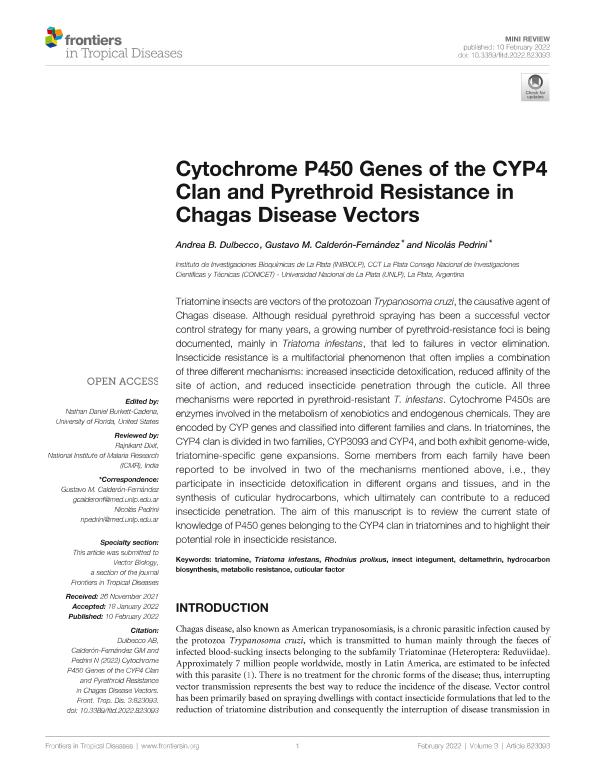Artículo
Cytochrome P450 Genes of the CYP4 Clan and Pyrethroid Resistance in Chagas Disease Vectors
Fecha de publicación:
02/2022
Editorial:
Frontiers Media
Revista:
Frontiers in Tropical Diseases
e-ISSN:
2673-7515
Idioma:
Inglés
Tipo de recurso:
Artículo publicado
Clasificación temática:
Resumen
Triatomine insects are vectors of the protozoan Trypanosoma cruzi, the causative agent of Chagas disease. Although residual pyrethroid spraying has been a successful vector control strategy for many years, a growing number of pyrethroid-resistance foci is being documented, mainly in Triatoma infestans, that led to failures in vector elimination. Insecticide resistance is a multifactorial phenomenon that often implies a combination of three different mechanisms: increased insecticide detoxification, reduced affinity of the site of action, and reduced insecticide penetration through the cuticle. All three mechanisms were reported in pyrethroid-resistant T. infestans. Cytochrome P450s are enzymes involved in the metabolism of xenobiotics and endogenous chemicals. They are encoded by CYP genes and classified into different families and clans. In triatomines, the CYP4 clan is divided in two families, CYP3093 and CYP4, and both exhibit genome-wide, triatomine-specific gene expansions. Some members from each family have been reported to be involved in two of the mechanisms mentioned above, i.e., they participate in insecticide detoxification in different organs and tissues, and in the synthesis of cuticular hydrocarbons, which ultimately can contribute to a reduced insecticide penetration. The aim of this manuscript is to review the current state of knowledge of P450 genes belonging to the CYP4 clan in triatomines and to highlight their potential role in insecticide resistance.
Palabras clave:
TRIATOMINE
,
INSECT INTEGUMENT
,
DELTAMETHRIN
Archivos asociados
Licencia
Identificadores
Colecciones
Articulos(INIBIOLP)
Articulos de INST.DE INVEST.BIOQUIMICAS DE LA PLATA
Articulos de INST.DE INVEST.BIOQUIMICAS DE LA PLATA
Citación
Dulbecco, Andrea Belen; Pedrini, Nicolás; Calderón Fernández, Gustavo Mario; Cytochrome P450 Genes of the CYP4 Clan and Pyrethroid Resistance in Chagas Disease Vectors; Frontiers Media; Frontiers in Tropical Diseases; 3; 2-2022; 1-8
Compartir
Altmétricas




